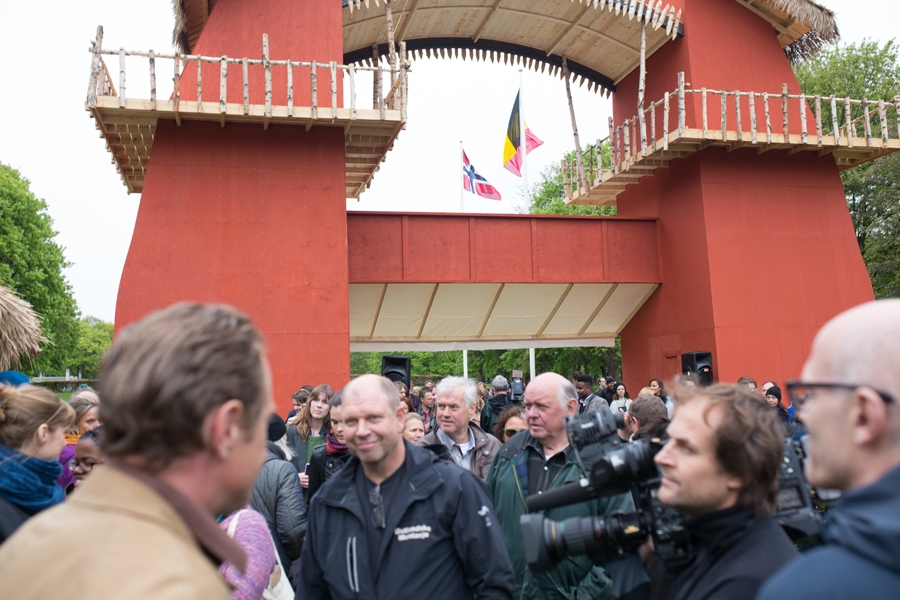It was a story that the Norwegian people forgot. In 1914, on the centenary of the Nordic country’s constitution, the king of Norway officiated over the opening of Kongolandsbyen, a temporary zoo in Oslo’s Vigelandsparken. Kongolandsbyen – or the ‘Congo Village’ – didn’t house animals, though; it was an exhibition of supposedly traditional Congolese houses, in which 80 Africans (most likely Senegalese) were ‘exhibited’ for five months for the amusement of the public. This was no minor distasteful sideshow to the rest of the centenary celebrations; more than half of the Norwegian population at the time are believed to have paid for a gawp at these ‘exotic’ specimens.
In 2013, 12 months before the bicentennial celebration of Norway’s constitution, two Oslo-based artists, Lars Cuzner and Mohamed Ali Fadlabi, staged a press conference to announce their plans to recreate the zoo under the title European Attraction Limited, faithfully rebuilding the huts, and requesting volunteers to occupy them. Other artists have trod similar ground previously. Guillermo Gómez-Peña and Coco Fusco’s The Year of the White Bear and Two Undiscovered Amerindians Visit the West (1992–4) saw Gómez-Peña and Fusco inhabit a cage dressed in an approximation of indigenous garb. Cuzner and Fadlabi, who are Swedish and Norwegian- Sudanese respectively and had not previously collaborated, claimed theirs was not a project of pointing a finger at Norway’s historic racism (after all, the 1914 incarnation of Kongolandsbyen followed in the footsteps of similar ventures in Europe and North America, staged from the seventeenth to early twentieth centuries, the colonial guilt of which Gómez-Peña and Fusco were playing with) but was posited as an investigation of collective amnesia. The artists spoke of discovering the Kongolandsbyen by chance, and that when they asked around, no one had heard of it and all expressed surprise and disbelief that it had ever existed.
A spokesperson for Norway’s Centre Against Racism went on record as saying, for example, ‘I think the only ones who will enjoy this are those with racist attitudes.’ Ironically, shortly after that statement, neo-Nazis claimed they would burn the project down
On the announcement of European Attraction Limited, all hell broke loose. So while this is a story of that particular project, it is also a portrait of artists losing control of their artwork, in spectacular fashion, once it goes into the public domain. The contemporary reaction to the project proved its most interesting element. The work’s centre shifted from the actual planned reconstruction – and questions of historic racism – to the media and public furore surrounding the work and contemporary attitudes. The artists became public figures overnight. Cuzner tells me he removed his telephone number and address from his website in light of the vitriol thrown his way. Wild rumours about the number of inhabitants and who they might be (which Cuzner and Fadlabi declined to confirm or deny) flew around; the Belgian ambassador protested the use of his country’s flag in the project; as a piece of satire, a choreographer called Sigurd Johan Heide travelled to Uganda, where he filmed himself dressed in Santa hat and sweater dancing to Norwegian traditional music; the artists were caricatured, mocked, eviscerated.
Most of the antagonism towards the project came from those who would identify themselves as politically leftwing, the artists tell me. A spokesperson for Norway’s Centre Against Racism went on record as saying, for example, ‘I think the only ones who will enjoy this are those with racist attitudes.’ Ironically, shortly after that statement, neo-Nazis claimed they would burn the project down. Cuzner tells me of being on a television chatshow with a representative of a charity that provides aid to African countries who painted the artists as racist. In their exchange, Cuzner suggested to this white Norwegian woman that perhaps Fadlabi, who is black and was not present in the studio, might be better placed to make that judgement. Her riposte was that Cuzner must have tricked Fadlabi into the project. As Cuzner is telling me this anecdote, Fadlabi interrupts, “As if the black man is too stupid to realise!”
On the day in mid-May this year when the village was at last opened, it slowly dawned on the assembled throng of media that they may have been tricked. There were indeed the huts, but there were no formal exhibits. No black people to be stared at (though several journalists approached anyone who happened to be black to ask whether they were an exhibit). People were free to come and inhabit the rough wood and straw structures during the day. When I visited the project a few weeks into its existence, small children were playing in the huts, teenagers were hanging out, a couple was kissing. It was all quite sweet. The zoo wasn’t some ‘other’, but ourselves – the West and our moral panic, our liberal guilt, our underlying fear of prejudice – that were on show.
This article was first published in the September 2014 issue.
